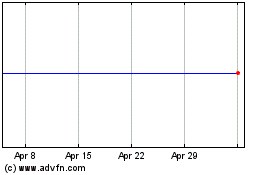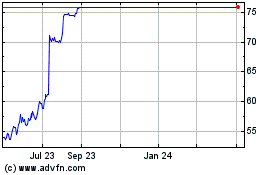Black Knight’s Mortgage Monitor: Tappable Equity at All-Time High, But Tax Code Changes Could Impact Homeowners’ Utiliza...
January 08 2018 - 9:00AM

Today, the Data & Analytics division of Black Knight, Inc.
(NYSE:BKI) released its latest Mortgage Monitor Report, based on
data as of the end of November 2017. This month, Black Knight finds
that tappable equity – the amount of equity available for
homeowners to borrow against before reaching a maximum 80 percent
total loan-to-value (LTV) ratio – is at an all-time high. However,
as Black Knight Data & Analytics Executive Vice President Ben
Graboske explained, recent changes to the U.S. tax code may have
implications for homeowners’ utilization of that equity.“As of the
end of Q3 2017, 42 million homeowners with a mortgage now have an
aggregate of nearly $5.4 trillion in equity available to borrow
against,” said Graboske. “That is an all-time high, and up more
than $3 trillion since the bottom of the market in 2012. Over 80
percent of all mortgage holders now have available equity to tap,
whether via first-lien cash-out refinances or home equity lines of
credit (HELOCs). We’ve noted in the past that as interest rates
rise from historic lows, HELOCs represented an increasingly
attractive option for these homeowners to access their available
equity without relinquishing interest rates below today’s
prevailing rate on their first-lien mortgages. However, with the
recently passed tax reform package, interest on these lines of
credit will no longer be deductible, which increases the post-tax
expense of HELOCs for those who itemize. While there are obviously
multiple factors to consider when identifying which method of
equity extraction makes more financial sense for a given borrower,
in many cases, for those with high unpaid principal balances who
are taking out lower line amounts, the math still favors HELOCs.
However – assuming interest on cash-out refinances remains
deductible – for low-to-moderate UPB borrowers taking out larger
amounts of equity, the post-tax math for those who will still
itemize under the increased standard deduction may now favor
cash-out refinances instead, even if the result is a slight
increase to first-lien interest rates.“As rates continue to rise
and the cost associated with increasing the rate on an entire
first-lien balance rises as well, the benefit pendulum will likely
swing back toward HELOCs. Even so, the change could certainly
impact HELOC lending volumes and loan amounts in the coming months
and years. To a certain degree, the same question holds true for
cash-out refinances, since tax debt for homeowners who will no
longer itemize becomes generally more expensive without mortgage
interest deduction in the equation. These refinances will likely be
an attractive source of secured debt in the future, but increased
post-tax costs may have a negative impact on originations. That
said, it still remains to be seen whether and to what extent tax
costs will impact borrower decisions in terms of either HELOCs or
cash-out refinances. At this point, only time will tell.”The
increase in equity, driven by rising home prices, has also
continued to shrink the population of underwater borrowers who owe
more on their mortgages than their homes are worth. The number of
underwater borrowers declined by 800,000 over the first nine months
of 2017, a 37 percent decline in negative equity since the start of
the year. Only 2.7 percent of homeowners with a mortgage
(approximately 1.36 million borrowers) now owe more than their home
is worth, the lowest such rate since 2006. Though still elevated
from pre-recession levels, the negative equity rate continues to
normalize. Even so, home prices in large portions of the country
remain below pre-recession peaks. While 36 states and 70
percent of Core Based Statistical Areas (CBSAs) have now surpassed
pre-recession home price peaks, 43 of the nation’s 100 largest
markets still lag behind.
As was reported in Black Knight’s most recent First Look news
release, other key results include:
| Total U.S. loan
delinquency rate: |
4.55% |
| Month-over-month change
in delinquency rate: |
2.54% |
| Total U.S. foreclosure
pre-sale inventory rate: |
0.66% |
| Month-over-month change
in foreclosure pre-sale inventory rate: |
-3.15% |
| States with highest
percentage of non-current* loans: |
MS, FL,
LA, AL, WV |
| States with lowest
percentage of non-current* loans: |
MT, MN,
OR, ND, CO |
| States with highest
percentage of seriously delinquent** loans: |
MS, FL,
LA, TX, AL |
*Non-current totals combine foreclosures and delinquencies as a
percent of active loans in that state. **Seriously delinquent loans
are those past-due 90 days or more.Totals are extrapolated based on
Black Knight’s loan-level database of mortgage assets.
About the Mortgage Monitor The Data &
Analytics division of Black Knight manages the nation's leading
repository of loan-level residential mortgage data and performance
information on the majority of the overall market, including tens
of millions of loans across the spectrum of credit products and
more than 160 million historical records. The company's research
experts carefully analyze this data to produce a summary
supplemented by dozens of charts and graphs that reflect trend and
point-in-time observations for the monthly Mortgage Monitor Report.
To review the full report, visit:
http://www.BKFS.com/CorporateInformation/NewsRoom/Pages/Mortgage-Monitor.aspx
About Black KnightBlack Knight
(NYSE:BKI) is a leading provider of integrated software, data and
analytics solutions that facilitate and automate many of the
business processes across the homeownership lifecycle.
Black Knight is committed to being a premier business
partner that clients rely on to achieve their strategic goals,
realize greater success and better serve their customers by
delivering best-in-class software, services and insights with a
relentless commitment to excellence, innovation, integrity and
leadership. For more information on Black Knight, please visit
http://www.blackknightinc.com/.
For more information:
Michelle
Kersch 904.854.5043 michelle.kersch@bkfs.com
Mitch Cohen704.890.8158mitch.cohen@bkfs.com
Black Knight (NYSE:BKI)
Historical Stock Chart
From Mar 2024 to Apr 2024

Black Knight (NYSE:BKI)
Historical Stock Chart
From Apr 2023 to Apr 2024
